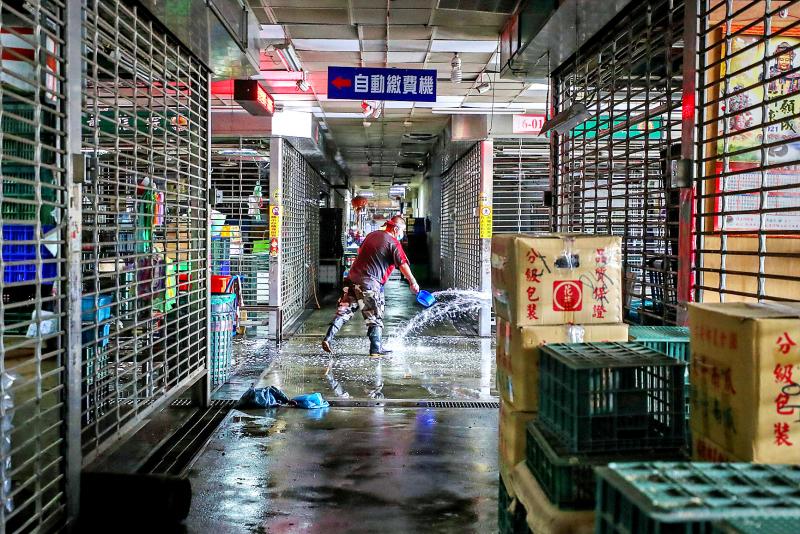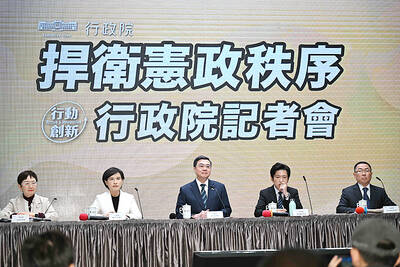The Central Epidemic Command Center (CECC) yesterday reported 75 locally transmitted COVID-19 infections, the lowest daily count since the nationwide level 3 alert was issued last month.
Minister of Health and Welfare Chen Shih-chung (陳時中), who heads the center, said the 75 local infections are 35 males and 40 females, aged from under five to over 80, and they began experiencing symptoms between June 8 and Sunday.
New Taipei City reported 38 cases, followed by Taipei with 22, Taoyuan with five, Miaoli County with three, Keelung and Taichung with two each, and Kaohsiung, Yunlin County and Changhua County with one each, CECC data showed.

Photo: CNA
The CECC also reported 20 deaths, 14 men and six women, who were aged from their 50s to their 90s, all of whom had underlying health conditions.
Of the 15 cases reported outside of Taipei and New Taipei City, the infection sources of all the cases had been identified, while contact tracing was being conducted.
While the situation is improving, wearing masks, washing hands and use of sanitizer must continue, Chen said.
The number of deaths remains high, but should fall in the coming days, he said.
Asked if the level 3 alert could be lowered on Monday next week, Chen said the issue is being discussed by various ministries and that the CECC would make an announcement when a decision is reached.
Centers for Disease Control Deputy Director-General Philip Lo (羅一鈞), deputy head of the CECC’s medical response division, said that 11 of the 20 people who died had started having symptoms last month, and that the period between the onset of symptoms and death has extended to an average of 17 days.
Among the confirmed cases reported after April 20, 2,373 people, or 18.4 percent, had suffered severe pneumonia or acute respiratory distress syndrome, Lo said, adding that 1,592 of them were aged 60 or older, or 35.4 percent of the confirmed cases in that age group.
There were 1,893 infected individuals being treated in designated COVID-19 hospital rooms as of noon yesterday, which is about 25 percent lower than the peak of 2,539 people on June 4, he said.
The number of infected patients in designated COVID-19 intensive care units has also dropped by 17 percent from a peak of 435 on June 7 to 383 as of noon yesterday, he added.
As significantly fewer COVID-19 patients had been hospitalized in the past week, the CECC has been moving some older infected people or those with underlying health conditions, who were in isolation in centralized quarantine facilities and enhanced quarantine hotels, to hospitals for better health monitoring, Lo said.
There are only about 1,270 people being isolated in centralized quarantine facilities and enhanced quarantine hotels, fewer than the number of patients hospitalized, he said.
Hospital and Social Welfare Organizations Administration Commission Director Wang Pi-sheng (王必勝), who on June 4 was assigned by the CECC to head a command center in Miaoli County after cluster infections were reported among workers at several electronics companies, said that the situation at the companies has been brought under control.
A total of 471 confirmed cases — 71 Taiwanese and 400 foreigners — had been found at eight factories and 26,250 tests had been performed on employees in the past 18 days, Wang said.
In related news, after a cluster of 45 infections associated with Taipei Agricultural Products Marketing Co had been reported since May 14, Taipei Mayor Ko Wen-je (柯文哲) yesterday said that the city government would administer COVID-19 vaccines to about 4,000 people associated with the company over the next three days.
However, vaccination is a preventive measure, not a treatment, and it would take at least two weeks for people to build resistance against the virus, Ko said, adding that contact tracing, testing and placing high-risk people in isolation would still be necessary to bring the outbreak under control.

The US government has signed defense cooperation agreements with Japan and the Philippines to boost the deterrence capabilities of countries in the first island chain, a report by the National Security Bureau (NSB) showed. The main countries on the first island chain include the two nations and Taiwan. The bureau is to present the report at a meeting of the legislature’s Foreign Affairs and National Defense Committee tomorrow. The US military has deployed Typhon missile systems to Japan’s Yamaguchi Prefecture and Zambales province in the Philippines during their joint military exercises. It has also installed NMESIS anti-ship systems in Japan’s Okinawa

‘WIN-WIN’: The Philippines, and central and eastern European countries are important potential drone cooperation partners, Minister of Foreign Affairs Lin Chia-lung said Minister of Foreign Affairs Lin Chia-lung (林佳龍) in an interview published yesterday confirmed that there are joint ventures between Taiwan and Poland in the drone industry. Lin made the remark in an exclusive interview with the Chinese-language Liberty Times (the Taipei Times’ sister paper). The government-backed Taiwan Excellence Drone International Business Opportunities Alliance and the Polish Chamber of Unmanned Systems on Wednesday last week signed a memorandum of understanding in Poland to develop a “non-China” supply chain for drones and work together on key technologies. Asked if Taiwan prioritized Poland among central and eastern European countries in drone collaboration, Lin

NO CONFIDENCE MOTION? The premier said that being toppled by the legislature for defending the Constitution would be a democratic badge of honor for him Premier Cho Jung-tai (卓榮泰) yesterday announced that the Cabinet would not countersign the amendments to the local revenue-sharing law passed by the Legislative Yuan last month. Cho said the decision not to countersign the amendments to the Act Governing the Allocation of Government Revenues and Expenditures (財政收支劃分法) was made in accordance with the Constitution. “The decision aims to safeguard our Constitution,” he said. The Constitution stipulates the president shall, in accordance with law, promulgate laws and issue mandates with the countersignature of the head of the Executive Yuan, or with the countersignatures of both the head of the Executive Yuan and ministers or

CABINET APPROVAL: People seeking assisted reproduction must be assessed to determine whether they would be adequate parents, the planned changes say Proposed amendments to the Assisted Reproduction Act (人工生殖法) advanced yesterday by the Executive Yuan would grant married lesbian couples and single women access to legal assisted reproductive services. The proposed revisions are “based on the fundamental principle of respecting women’s reproductive autonomy,” Cabinet spokesperson Michelle Lee (李慧芝) quoted Vice Premier Cheng Li-chiun (鄭麗君), who presided over a Cabinet meeting earlier yesterday, as saying at the briefing. The draft amendment would be submitted to the legislature for review. The Ministry of Health and Welfare, which proposed the amendments, said that experts on children’s rights, gender equality, law and medicine attended cross-disciplinary meetings, adding that